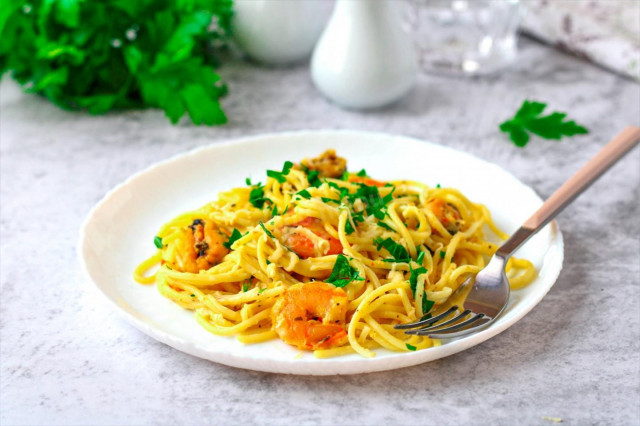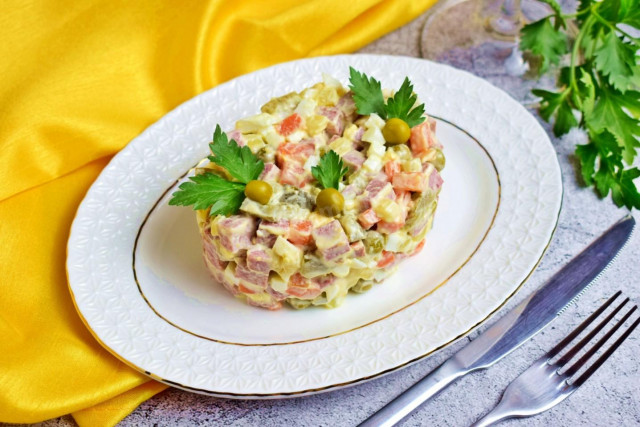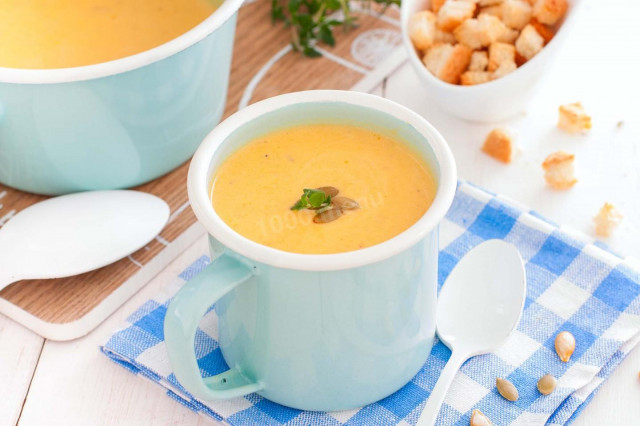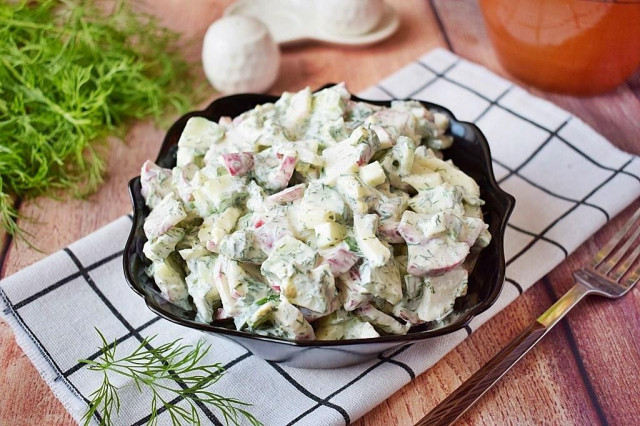Composition / ingredients
Step-by-step cooking
Step 1:
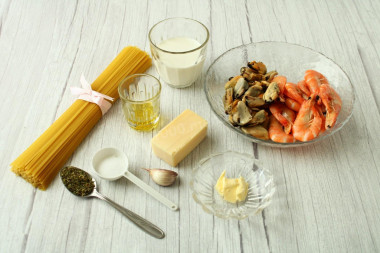
How to make pasta with seafood in cream sauce? Prepare the necessary ingredients. You can take several types of seafood separately, or use a ready-made sea cocktail. I have shrimp and mussels. It is desirable that the cream be at room temperature. Take the paste from durum wheat, it is less than others boiled.
Step 2:
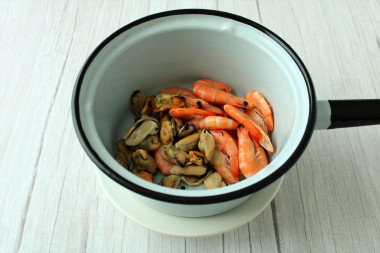
Pre-defrost frozen seafood at room temperature or in the refrigerator. Seafood should thaw gradually, without sudden temperature changes, so that they do not lose their taste qualities. Rinse the seafood under cold water, put it on a sieve or colander to drain the water. Dry the seafood well to remove excess moisture from them as much as possible.
Step 3:
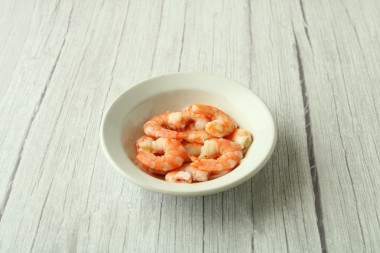
Peel the shrimp from the head and shell. Make a small incision on top along the shrimp's body to remove the intestinal vein. If necessary, rinse the shrimp again and dry well.
Step 4:
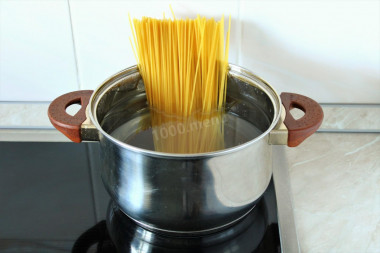
The pasta must be cooked in a large amount of water so that it does not stick together, so take a suitable pot by volume. Boil the pasta in boiling salted water until al dente, that is, slightly undercooked.
Step 5:

Flip the pasta into a colander to drain the water.
Step 6:

Seafood sauce can be prepared in parallel with pasta. Peel the garlic, cut into plates. In a frying pan, lightly heat the olive oil and butter. Simmer the garlic over moderate heat for 1 minute to make the oil fragrant. Remove the garlic from the pan. You can throw it away, we don't need it anymore.
Step 7:
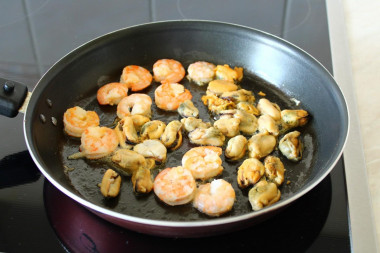
Put the seafood in the pan. Fry them over moderate heat, turning them over periodically, for about 3 minutes, until golden brown. There should be no excess moisture in seafood. Otherwise, they will be stewed first and then fried, which will increase the cooking time. And this cannot be allowed, since the tender meat of sea delicacies will become coarse and tough.
Step 8:
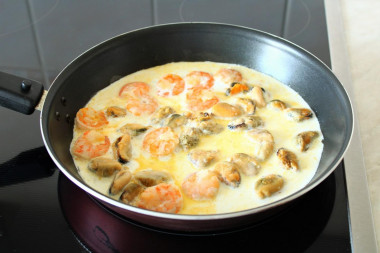
Pour cream into the pan, turn up the heat.
Step 9:

Add fragrant herbs, a little salt. You can add ground black pepper. Bring the sauce to a boil, reduce the heat.
Step 10:
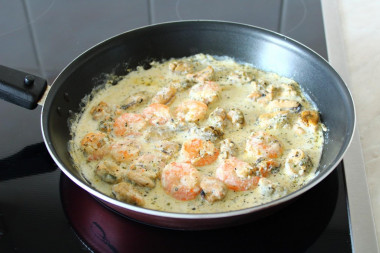
Simmer the sauce for 5 minutes, stirring occasionally. I have large shrimp and mussels. If your seafood is smaller, it is enough to put out the sauce for 2-3 minutes.
Step 11:
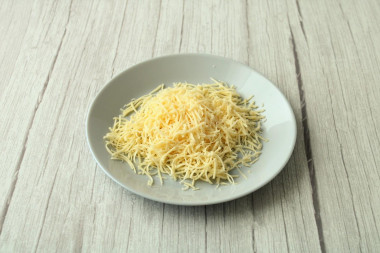
Chop the cheese on a fine grater. Sprinkle a little cheese for serving.
Step 12:

Add grated cheese to the sauce, mix. Cheese will give the sauce a more viscous consistency and make the taste more saturated. When adding salt to the sauce, consider the salinity of the cheese.
Step 13:
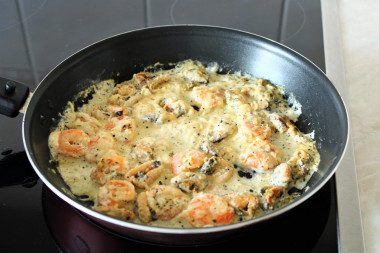
Simmer the sauce so that the cheese melts.
Step 14:
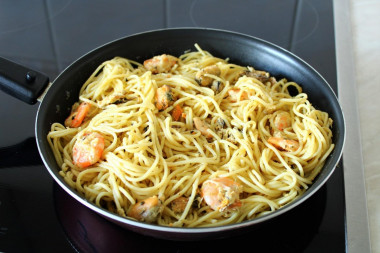
Put the finished pasta in the pan with the sauce, mix. Heat the pasta with the sauce for 1 minute and serve immediately.
Step 15:
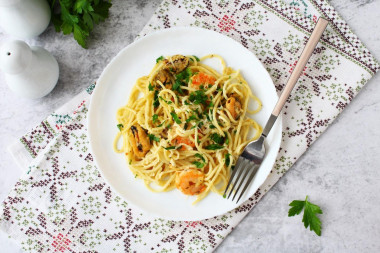
When serving, sprinkle the pasta on top with the remaining cheese and chopped fresh herbs. Bon appetit!
Pasta is best served immediately after cooking. After cooling, the sauce will thicken, and the dish will no longer have such a delicate taste.
A glass of white wine will complement the pasta well. This wine perfectly reveals the taste of seafood delicacies.
I would slightly increase the amount of cream so that there is more sauce.
Use oil with a high smoking temperature for frying! Any oils are useful only until a certain temperature is reached - the point of smoking, at which the oil begins to burn and toxic substances, including carcinogens, are formed in it.
Unrefined oils, with rare exceptions, have a low smoking point. There are a lot of unfiltered organic particles in them, which quickly begin to burn.
Refined oils are more resistant to heating, and their smoking point is higher. If you are going to cook food in the oven, on a frying pan or grill, make sure that you use oil with a high smoking point. The most common of the oils with a high smoking point: refined varieties of sunflower, olive and grape.
How to boil pasta properly? Take a spacious saucepan, pour water at the rate of 100 grams of pasta 1 liter of water. The main thing is that the products float freely in the liquid. Add salt to taste. Bring the water to a boil. It is important to put the pasta in boiling water, otherwise they may stick together. Cook over medium heat, stirring occasionally, until fully cooked or al dente (cooking time is always indicated on the package). Put the finished pasta in a colander and let the liquid drain. It is not necessary to rinse the finished pasta with water. If you do not plan to immediately mix the pasta with the sauce, then in order to avoid sticking hot pasta, you can send them from the colander back into the pan and add a teaspoon of olive oil (or a piece of butter)and mix gently.
Caloric content of the products possible in the composition of the dish
- Canned shrimp - 81 kcal/100g
- Boiled shrimp - 95 kcal/100g
- Shrimps peeled frozen - 60 kcal/100g
- Fresh shrimp - 97 kcal/100g
- Buttermilk - 36 kcal/100g
- Cream of 20% fat content - 300 kcal/100g
- Cream of 10% fat content - 120 kcal/100g
- Cream - 300 kcal/100g
- Dutch cheese - 352 kcal/100g
- Swiss cheese - 335 kcal/100g
- Russian cheese - 366 kcal/100g
- Kostroma cheese - 345 kcal/100g
- Yaroslavsky cheese - 361 kcal/100g
- Altai cheese 50% fat content - 356 kcal/100g
- Soviet cheese - 400 kcal/100g
- Cheese "steppe" - 362 kcal/100g
- Uglich cheese - 347 kcal/100g
- Poshekhonsky cheese - 350 kcal/100g
- Lambert cheese - 377 kcal/100g
- Appnzeller cheese with 50% fat content - 400 kcal/100g
- Chester cheese with 50% fat content - 363 kcal/100g
- Edamer cheese with 40% fat content - 340 kcal/100g
- Cheese with mushrooms of 50% fat content - 395 kcal/100g
- Emmental cheese with 45% fat content - 420 kcal/100g
- Gouda cheese with 45% fat content - 356 kcal/100g
- Aiadeus cheese - 364 kcal/100g
- Dom blanc cheese (semi-hard) - 360 kcal/100g
- Cheese "lo spalmino" - 61 kcal/100g
- Cheese "etorki" (sheep, hard) - 401 kcal/100g
- White cheese - 100 kcal/100g
- Fat yellow cheese - 260 kcal/100g
- Altai cheese - 355 kcal/100g
- Kaunas cheese - 355 kcal/100g
- Latvian cheese - 316 kcal/100g
- Limburger cheese - 327 kcal/100g
- Lithuanian cheese - 250 kcal/100g
- Lake cheese - 350 kcal/100g
- Gruyere cheese - 396 kcal/100g
- Garlic - 143 kcal/100g
- Butter 82% - 734 kcal/100g
- Amateur unsalted butter - 709 kcal/100g
- Unsalted peasant butter - 661 kcal/100g
- Peasant salted butter - 652 kcal/100g
- Melted butter - 869 kcal/100g
- Fried mussels - 59 kcal/100g
- Boiled mussels - 50 kcal/100g
- Salt - 0 kcal/100g
- Water - 0 kcal/100g
- Olive oil - 913 kcal/100g
- Herb mixture - 259 kcal/100g
- Spaghetti - 338 kcal/100g

